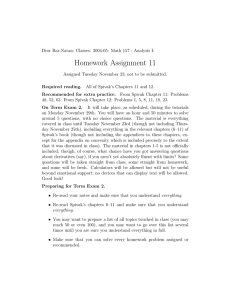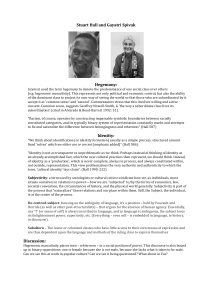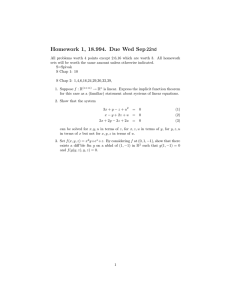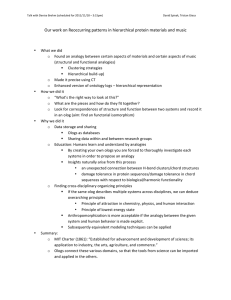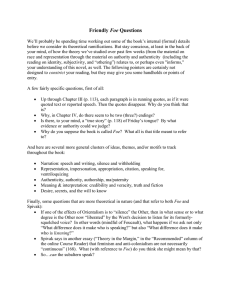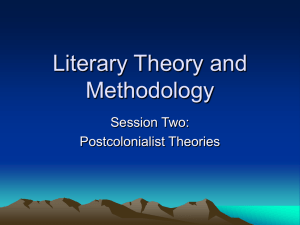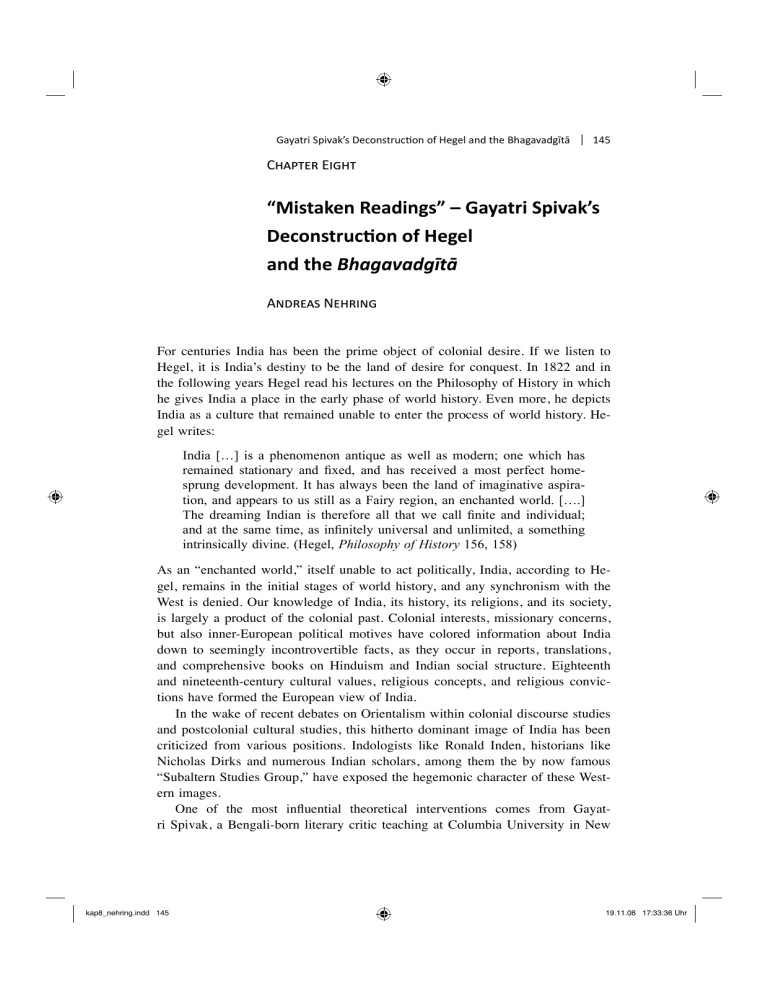
Gayatri Spivak’s Deconstruc on of Hegel and the Bhagavadgītā | 145 C E “Mistaken Readings” – Gayatri Spivak’s DeconstrucƟon of Hegel and the Bhagavadgītā A N For centuries India has been the prime object of colonial desire. If we listen to Hegel, it is India’s destiny to be the land of desire for conquest. In 1822 and in the following years Hegel read his lectures on the Philosophy of History in which he gives India a place in the early phase of world history. Even more, he depicts India as a culture that remained unable to enter the process of world history. Hegel writes: India […] is a phenomenon antique as well as modern; one which has remained stationary and fixed, and has received a most perfect homesprung development. It has always been the land of imaginative aspiration, and appears to us still as a Fairy region, an enchanted world. [….] The dreaming Indian is therefore all that we call finite and individual; and at the same time, as infinitely universal and unlimited, a something intrinsically divine. (Hegel, Philosophy of History 156, 158) As an “enchanted world,” itself unable to act politically, India, according to Hegel, remains in the initial stages of world history, and any synchronism with the West is denied. Our knowledge of India, its history, its religions, and its society, is largely a product of the colonial past. Colonial interests, missionary concerns, but also inner-European political motives have colored information about India down to seemingly incontrovertible facts, as they occur in reports, translations, and comprehensive books on Hinduism and Indian social structure. Eighteenth and nineteenth-century cultural values, religious concepts, and religious convictions have formed the European view of India. In the wake of recent debates on Orientalism within colonial discourse studies and postcolonial cultural studies, this hitherto dominant image of India has been criticized from various positions. Indologists like Ronald Inden, historians like Nicholas Dirks and numerous Indian scholars, among them the by now famous “Subaltern Studies Group,” have exposed the hegemonic character of these Western images. One of the most influential theoretical interventions comes from Gayatri Spivak, a Bengali-born literary critic teaching at Columbia University in New kap8_nehring.indd 145 19.11.08 17:33:36 Uhr 146 | Andreas Nehring York, who throughout her work has focused on India and Indian themes. Spivak has even offered a deconstructive reading of Hegel’s commentaries on the Bhagavadgītā, which are scattered in his Philosophy of History, his Lectures on the Aesthetics, and his Lectures on the History of Philosophy. As a religious studies scholar I am interested in the role Indian texts play in scholarly discourses, and a symposium on ‘Cultural Encounters and the Discourses of Scholarship’ offers an opportunity to raise some questions regarding the theoretical implications of this cultural encounter. This is even more relevant since the Bhagavadgītā, written somewhere between 200 BC and AD 200, has acquired the status of a “cultural text,” to use Aleida Assmann’s term (Assmann 232), a text that is crucially significant for large parts of Hindu society. It is one of the most important and widely distributed and read Hindu texts in India today. Nonviolence activists like Mahatma Gandhi have frequently referred to what is commonly called ‘the Gītā’ as a foundational text of India’s cultural pluralism and lived tolerance. And the text has just as often been used (and continues to be used) since the early nineteenth century by Hindu nationalists and religiously intolerant radicals who interpret the Gītā as a national text of Hindu exclusivism. The distinctive role of the Bhagavadgītā in modern Hindu society is nevertheless heavily determined by colonial readings of this text. Charles Wilkins’ translation of Bhagavadgītā (1785) was received with enthusiasm by the Romantic authors in Germany as well as in Britain (Drew 80; Halbfass 78-9; Sharpe 15-6). Johann Gottfried Herder (1744-1803) was one of the first Germans who had certainly read the Gītā by the late 1780s. He mentions the book and quotes from it in his Ideen zur Philosophie der Geschichte. But Herder never gave the Gītā the prominence it gained in later European discourses on India and in the discourses on Indian cultural identity among reformers of Hinduism in India. For Herder the Gītā was one of many relevant Indian texts, nevertheless he strongly promoted the idea that although traces of degeneration like the caste system and the idea of reincarnation can be found in India, India had also acquired the deepest wisdom, which could be of value even for Europeans. He found evidence for this deeply rooted wisdom and virtue in India’s scriptural sources. Forty years later, the knowledge about India and Indian religions had grown enormously. The foundation of the Asiatic Society (1784) in Bengal and the introduction of Indology to European universities enabled more in-depth studies of Indian texts in the original language. In 1825, August Wilhelm Schlegel (1767-1845) translated the Gītā into German, and in that same year Wilhelm von Humboldt gave a long lecture on the Gītā, which he considered to be a “Naturdichtung,” an excellent example of philosophical poetry and not a religious text (Humboldt, quoted in Sharpe 19). According to Humboldt, the importance of the Gītā, not only for India but for the whole of humanity, is to be found in its emphasis on the immutable dharma, the eternal law and code of conduct, in combination with individual piety as expressed in bhakti devotion. Since the mid-nineteenth century the text of the Gītā has been translated into several languages and kap8_nehring.indd 146 19.11.08 17:33:37 Uhr Gayatri Spivak’s Deconstruc on of Hegel and the Bhagavadgītā | 147 has gained a status as one of the deepest spiritual texts of humanity among theosophical as well as other India-enthusiastic authors. Hegel published two long review articles on Humboldt’s commentaries on the Gītā in which he critically investigates the Romantic conviction that Indian wisdom, being rooted in the oldest historical tradition, has to be esteemed as a corrective of Western enlightened rationality. Hegel’s interest in India, as Wilhelm Halbfass has pointed out, was interwoven with his critique of the Romantic enthusiasm for origins (Halbfass 116). By the time Hegel published his first review article in 1826, Henry Thomas Colebrooke had given a first detailed account of the systems of Indian philosophy, which initially appeared in the Transactions of the Royal Asiatic Society and was compiled in his Miscellaneous Essays ten years later. Hegel was an avid reader of the latest Indological research of his time and his knowledge of Indian philosophy was mainly informed by these contemporary accounts. In his reflections on Indian philosophy he admits that these representations of Indian thought are still limited and that no overall account of an Indian philosophical doctrine can be gained from the Western texts at hand. Only the command of ancient Indian languages would enable the Western philosopher to read Indian philosophical texts and to gain access to all philosophical and mythological systems in order to compare them with one another (Hegel, “BhagavadGita” 1: 133). Hegel assumes that the Gītā is a text that is particularly suitable for giving a clear impression of the peak of Indian philosophy (Hegel, “Bhagavad-Gita” 1: 134). However, in her reading of Hegel, Gayatri Spivak does not focus so much on these two review articles but on Hegel’s Lectures on the Aesthetics. As a literary critic by training, I will concentrate on a couple of paragraphs from the Lectures on the Aesthetics. Because I am Indian and was born a Hindu, I will also attempt to satisfy the increasing, and on occasion somewhat dubious, demand that ethnics speak for themselves, by focusing on a bit in Hegel on Indian poetry. (Spivak, Critique 40) It is this “dubious demand” to speak for oneself as a native that Spivak is addressing in her opus magnum A Critique of Postcolonial Reason, in which she is tracking “the figure of the Native Informant through the various practices: philosophy, literature, history, culture” (Spivak, Critique ix). I will follow her on this track as a student of religion who is especially interested, first, in the role of theory in criticizing cultural encounters with the “Other,” respectively Western representations of, it; secondly, in Spivak’s deconstructive reading of Hegel and the Gītā; and, thirdly, in Indian reactions to Western readings of the Gītā and the Indian appropriation of this text as a cultural monument. kap8_nehring.indd 147 19.11.08 17:33:37 Uhr 148 | Andreas Nehring The Role of Theory in Criticizing Cultural Encounters Some of the most radical criticism coming out of the West today is the result of an interested desire to conserve the subject of the West, or the West as Subject. Gayatri Spivak, “Can the Subalternspeak?” Until today, this famous opening of Spivak’s widely discussed essay, written twenty years ago, raises questions of whether and how our ‘Discourses of Scholarship’ on cultural encounters are involved in Eurocentric or neocolonial hegemonic thought structures. Spivak analyzes a discussion between Michel Foucault and Gilles Deleuze about the production of theory as action and the impossibility of distinguishing between representation as theoretical reflection and action as theoretical practice. Theory, in other words, is always involved in the question of power. Spivak nevertheless criticizes in Deleuze and Foucault that in their activist concern for “Chinese Maoism” and the “Workers’ Struggle” they implement a sovereign subject position by pretending that the subject has no geopolitical determinations. While the Western intellectual “must attempt to disclose and know the discourse of society’s other” and can be named and differentiated, the “other,” i.e., “Maoism” and “Workers’ Struggle,” remain anonymous ciphers in a discourse that “symptomatically renders the Other transparent.” Spivak acknowledges the importance of the theoretical production of this “new Philosophy” and yet accuses it of ignoring “the question of ideology and their own implication in intellectual and economic history” (Spivak, Critique 248-9). What then can be the critical role of theory in reading magisterial texts from the Western philosophical tradition? The problem of saying something new today, as Roland Barthes already pointed out in an interview in 1974, is that a historical shift of objects has taken place. He argues: Today the avant-garde object is essentially theoretical: the double pressure of politics and intellectuals ensures that it is now theoretical positions (and their exposition) which are avant-garde and not necessarily creative works themselves. (Barthes 191) Gayatri Spivak’s A Critique of Postcolonial Reason, a book of 350 pages published in 1999, is certainly not avant-garde in its overall structure or in the topics she deals with. In four long chapters, A Critique of Postcolonial Reason looks at the general topics of philosophy, literature, history, and culture, using a transdisciplinary approach that Spivak in an interview with Jason Boog refers to as a “literature trade” (Boog 25). She engages with the traditional canon of philosophy by reading Kant, Hegel, and Marx. She then focuses on Charlotte Brontë’s Jane Eyre, Mary Shelley’s Frankenstein, and Coetzee’s Foe, as well as on various documents from the colonial archives. Throughout her book she stresses the inaccessibility of the cultural “Other” and this emphasis is accompanied by metacritical kap8_nehring.indd 148 19.11.08 17:33:37 Uhr Gayatri Spivak’s Deconstruc on of Hegel and the Bhagavadgītā | 149 reflections influenced by Marxism, feminism, and poststructuralist deconstruction. What makes her approach a specifically challenging one is Spivak’s concern that her theoretical interventions relate to culturally and historically specific contexts. As Henry Staten points out, “there is always too much history, too much human reality beyond what language can adequately represent” (Staten 111). How can we identify a new or even an avant-garde theoretical position in such readings? Roland Barthes again gives a first opening. “Theory,” he says, “which is the decisive practice of the avant-garde, has no progressive role in itself – its active role is to reveal as past that what we still believe to be present: theory mortifies, and that is what makes it avant-garde” (Barthes 191). If, as Barthes puts it, theory “mortifies” by taking a position in the present and if it critiques what is believed to organize the present, it constantly has to (re)invent itself in order not after all to mortify itself. Theory as action has to invent “theoretical positions,” and since this invention has no proper domain of objects, it must be seen as an instance of catachresis, a term Spivak likes to use for pointing out contradictions in reading positions. Spivak takes a theoretical position by referring to her readings of canonical texts of the Western philosophical tradition as “Mistaken Readings.” This involves two aspects on which I would like to comment: 1. that these texts must be read from an angle or a perspective which differs from the disciplinary conventions of the Western philosophical traditions and 2. that a mistaken reading involves “mistaken significations,” deferred naming, and improper metaphors in order to open re-significations and reinscriptions of a seemingly fixed philosophical terminology. Catachresis, in Spivak’s use of the term, is a figurative and performative strategy that indicates the unsettling capacity of linguistic representations of the world. Spivak not only questions the idea of a stable and comprehensible relation between language and the world; she goes beyond other theoretical positions in the poststructuralist field by always relating her reflections on the relation between language and world to a culturally and historically specific context. She focuses specifically on the use of language in colonial discourses. In her reading, the comprehension model of the relation between language and reality employed in colonial discourses appears to be a hegemonic one through which the West was able to constitute a stable and controllable reality as the object of knowledge. In this knowledge formation, the “Others” not only have no voice, they are even foreclosed from the production of knowledge in order to render this production pure. Spivak uses the term ‘foreclosure’ by referring to the psychoanalysis of Jacques Lacan and Laplanche/Pontalis (166-169) in order to read the “pre-emergence of narrative as ethical instantiation” (Spivak, Critique 4). Spivak argues that postcolonial studies are in danger of relating to colonialism or the problem of Western dominance only diachronically by focusing predominantly on the representation of the colonized in Western texts. Postcolonial studies in this line of analysis, she argues, collaborate with the hegemonic West- kap8_nehring.indd 149 19.11.08 17:33:37 Uhr 150 | Andreas Nehring ern project to constitute an intending subject behind a seemingly transparent text. Her own theoretical move is a deconstructive reading whose aim is to show that this claimed purity or transparency is a fiction and never existed in any consistent fashion. “Knowledge of the other subject,” she claims, “is theoretically impossible” (Spivak, Critique 283). Of course this statement also applies to all other subjects, but Spivak focuses on specifically cultured subjects, namely, those who are foreclosed from dominant discourses: the subaltern. Her book can be read as an attempt to track the trace of this other subject of Western discourses in dominant Western texts. Since knowledge of this other subject is theoretically impossible, the “other” always remains an “(im)possible perspective” (Spivak, Critique 9). Spivak does not join those voices that critically advise the producers of neocolonial knowledge to admit “’that one cannot know the cultures of other places, other times’ and then proceed to diagnose hegemonic readings” (Spivak, Critique 50). Her own approach could rather be called an ‘interventionist deconstruction.’ That which has been effaced from the “symbolic order” (Lacan) of the dominant discourse in order to make it appear pure, leaves a trace, which, if taken up and followed, leads beyond the transparency of language. What has been foreclosed from the symbolic order Spivak calls the “Native Informant,” “a name for that mark of expulsion from the name of Man” (Spivak, Critique 6) – “Man” with capital “M,” used as a synonym for Western humanism and rationalism. Her aim is to track the figure of the “Native Informant” through the various disciplinary practices she touches on in her book. The term “Native Informant” has been borrowed from Ethnology. The ‘Writing Culture’ debate during the late 1980s expounded the problem of the production of ethnographic texts and criticized that in this enterprise the native voice disappears behind the objectifying representation of another culture. The then new approach to ethnography struggled with two related problems, namely, that the attempt to know the cultural other would have to treat him or her as an object of knowledge, and thereby deny him/her subjectivity, and that the attempt to present a “thick description” of the “other,” would offer a mirror image of one’s own culture. By referring to this critical self-reflection of ethnology Spivak identifies this “other,” whom she calls native informant, as a blank space, inscribed in classical Western ethnographic, philosophical, literary, and cultural texts. But she goes a step further by establishing the native informant as a theoretical position that “mortifies” (Barthes) in order to invent itself. Spivak is naming her/him “a mark crossing out the impossibility of the ethical relation” (Spivak, Critique 6). I take this paradoxical phrase to say that the impossibility of an ethical relation cannot be annihilated. It can only be crossed out, that is, the impossibility of an ethical relation is put “sous rature,” or as Spivak calls it in her translator’s introduction to Derrida’s Of Grammatology, it is put “under erasure” (Spivak, “Translator’s Preface” xiv). The purpose of this visible act of deletion is to show “that our own language is twisted and bent even as it guides us. Writ- kap8_nehring.indd 150 19.11.08 17:33:37 Uhr Gayatri Spivak’s Deconstruc on of Hegel and the Bhagavadgītā | 151 ing ‘under erasure’ is the mark of this contortion” (Spivak, “Translator’s Preface” xiv). The native informant is neither a position that can transform the impossibility of an ethical relation into a positive possibility, nor a position of absolute difference that can render the impossibility of that ethical relation absolute. Spivak criticizes that too often the position of the native informant is uncritically and unconsciously taken over by those who claim a subject-position in the postcolonial field by positioning themselves as representative native informants from the South or as representatives for diasporic identities. Spivak calls them benevolent cultural nativists who instrumentalize cultural identity positions in order to represent themselves to the dominant culture (Spivak, Critique 6). For Spivak the native informant is less a subject-position that can be be traced, outlined, and identified, than a particular reading strategy or strategic perspective, “a kind of deconstructive lever through which questions of radical alterity, responsibility, and persistent critique can be constantly re-posed” (Rai, “Review” 1). In that sense it is a theoretical perspective of action, a perspective that mortifies by constantly deferring reading positions. By this strategic move Spivak tries to draw the reader into a process of responsibility and accountability, a process she once called in an interview an “ethical semiosis” (Sanders, “Interview” 110-11). By ethical semiosis she has in mind a multilayered process, a responsibility and accountability that is at the same time an act of translation in which the ego is put together. This translational act is not merely a speech act: Spivak throughout her work relates the ethical semiosis to the inaccessible fullness of time and context within which subjectivity can and must be located. Spivak’s concern with specific contexts is what makes her postcolonial theoretical approach appear so radical. As Henry Staten has pointed out, it is this experience of the impossible perspective of the “Other” in a specific context that Spivak calls the perspective of the native informant (Staten, “Tracking” 111). In an appendix to her book, called “The Setting to Work of Deconstruction” Spivak refers to Derrida who in his later, rather “affirmative” phase addressed différance by using the concept-metaphor of “the experience of the impossible:” “If radical alterity was earlier conceived of as a methodologically necessary presupposition that is effaced in being named, now the category of presupposition is deliberately blurred and made more vulnerable as ‘experience’” (Spivak, Critique 426). Gayatri Spivak’s Deconstructive Reading of Hegel and the Gītā We will see how Spivak is employing this theoretical premise in her deconstructive reading of Hegel and the Gītā. This reading she calls ‘mistaken,’ “for it attempts to transform into a reading-position the site of the ‘native informant’ in anthropology, a site that can only be read, by definition, for the production of definitive descriptions” (Spivak, Critique 49). The experience of an impossible per- kap8_nehring.indd 151 19.11.08 17:33:37 Uhr 152 | Andreas Nehring spective of the “other” requires a differentiation between various contextual figurations of the native informant. Spivak urges her readers to contextualize the anthropological figure of the native informant by investigating the difference in the opposition of the Australian Aborigine and groups like the Fuegans [Spivak identified them as foreclosed native informants in Kant’s Critique of Judgement; AN] and the production of the dominant Hindu colonial subject, rather than positing a unified “third world,” lost, or more dubiously, found lodged exclusively in the ethnic minorities in the First. (Spivak, Critique 49) Hegel, as has already been pointed out, does not give India a prominent position on the epistemograph of history, the graph on which “the Spirit acts out the scenario of Self-knowledge” (Spivak, Critique 40). On the chronograph of the Hegelian Spirit, India is a static moment in the beginning, and it remains there, unable to push into history. In his Lectures on the Aesthetics Hegel argues that India has to remain in a static position because neither Indian art nor Indian philosophy permits a dialectical process. The Indians, according to Hegel, remain fixed in their determinatedness by sticking to endlessly reiterated concepts (Spivak, Critique 40). Even Indian art is nothing more but a permanent repetition of the same. The essence of Indian art is that it restlessly moves back and forth. As Hegel writes: From one side it is driven into the opposite one, and out of this is pushed back again into the first; without rest it is just thrown hither and thither, and in the oscillation and fermentation of this striving for a solution thinks it has already found appeasement. (Hegel, Aesthetics 1: 333-4) In a similar way, Indian literature, and especially the Bhagavadgītā, is according to Hegel, repetitive by bringing “before our eyes […] always one and the same thing over again” (Spivak, Critique 44). Before I go into Spivak’s reading, I will briefly sketch out the content of the Gītā. The Bhagavadgītā (Song of God) is a Sanskrit text. While for Hegel the Gītā is not a document of history, it is possible to read this differently. The Gītā must be situated within the great epic called Mahābhārata, of which it is a small albeit important part. The Bhagavad Gītā is considered and revered as sacred by many Hindu traditions, especially by followers of Krishna. To read this text today implies the necessity of working oneself through different layers of Indological, orientalist, and Romanticist interpretations as well as interpretations from neoHindu movements and from popular culture in India today, television series as well as movies that take this text as their basis. The content of the Gītā is a conversation between Krishna and Arjuna that took place on a battlefield called Kurukshetra on the eve otf the great battle between the Pandavas and the Kauravas, two clans that descended from the same ancestors. Arjuna, one of the warriors, is facing the moral dilemma of whether he should fight in the battle and run the risk of killing some of his relatives or kap8_nehring.indd 152 19.11.08 17:33:37 Uhr Gayatri Spivak’s Deconstruc on of Hegel and the Bhagavadgītā | 153 whether he should renounce violence and become a sanmyasin, spending the rest of his life meditating and begging for alms. Krishna, Arjuna’s charioteer, is now responding to Arjuna’s confusion and moral dilemma, and he explains to Arjuna his duties as a warrior and Prince and elaborates on a number of different philosophical positions and margas (paths) to liberation like karma-marga, (the path of action), bhakti-marga (the path of devotion) and jnana-marga (the path of knowledge), using examples and analogies. During the discourse, Krishna reveals his identity to Arjuna as the Supreme Being (Bhagavan). In search of traces of the native informant, Spivak’s intention is not to critique the Hegelian orientalist representation of this Eastern text by establishing an argument of the socio-political relevance of Arjuna’s discourse with Krishna for the history of India, although she refers to the Indian historian Romila Tapar’s reflections on the Gītā as a passage text that leads from an earlier semiotic field of lineage to an emerging one of the developing state. Neither does Spivak imagine a “native informant” contemporary with Hegel, rather she aims at a deconstructive reading of the difference or even opposition between Hegel and the Gītā. Spivak sees a structural complicity between Hegel’s argument and the Gītā in that both manipulate time. Spivak’s reading, which she calls “mistaken,” focuses on the “play of law and history” in the Gītā (Spivak, Critique 47). It is not the historical quest that is of relevance here, not the problem of the historicity of the text or the events narrated in the Gītā, but how the question of history is raised and performed within the narrative. With this focus Spivak elaborates an enormously relevant point for a discursive reading of modern interpretations and commentators of the Gītā in the nineteenth and twentieth centuries. A mere critique of Western orientalist representations of Indian texts, which is still prominent in much of postcolonial studies, appears for Spivak to be after all “a legitimation-by-reversal of the colonial attitude itself” (Spivak, Critique 39). It is the complicity of both, Hegel and the Gītā, that has contributed to turning the Gītā from text into scripture in modern Hindu discourse. Hegel as well as the Gītā deal with the question of history and both offer a concept of “Time as Law.” Spivak focuses on one moment in the discourse of Arjuna and Krishna in which the question of history comes up. After Krishna in the third canto of the Gītā expounds to Arjuna age-old Yoga teachings, which he obviously had already taught to the sun (vivaîvat/sñrya), Arjuna in the opening of the fourth canto asks Krishna about the legitimation of his historical authority: “Your birth was later and the birth of vivaîvat was earlier. How should I know that you said all this first?” To this Krishna gives three kinds of answers: 1. We come and go many times. I know the times and you do not. 2. I become by inhabiting my own nature through my own phenomenal possibility. I am above all beings. 3. I can incarnate whenever it is necessary, or when the dharma is in decline. (Spivak, Critique 51-2). kap8_nehring.indd 153 19.11.08 17:33:37 Uhr 154 | Andreas Nehring Spivak now brings up the question of history and she reads the exhortation of Krishna as a negation and sublation of history. Krishna contains all history within his true self, only revealing this to Arjuna by special dispensation. Krishna is unborn and imperishable, and manifests whenever the law is in decline, but was already there at the beginning. Human time is a lesser time here (Spivak, Critique 53). Historical timing is overridden into a cosmological and ontological order of time, which is ruled by Krishna. By revealing the cosmic order of his being, Krishna presents himself as the best of an infinite number of historical possibilities. It is this presentation of excellence that Hegel criticizes as repetitive. (Hegel, Aesthetics 1: 333). Spivak’s reading aims, as mentioned earlier, at a deconstruction of the opposition of Hegel and the Gītā. Her intention is to show “that ‘Hegel’ and the ‘Gita’ can be read as two rather different versions of the manipulation of the question of history in a political interest, for the apparent disclosure of the Law” (Spivak, Critique 58). These two different versions nevertheless inform modern interpretations of the Gītā. The native informant “is inscribed as evidence in the production of the scientific or disciplinary European knowledge of the culture of the others” (Spivak, Critique 66-7). This knowledge has been disseminated in colonial India. The search for history and the origin of culture has become a prime enterprise in the anticolonial nationalist movement during the nineteenth and early twentieth centuries. “Timing” (the lived time) in this movement has been subordinated to “Time” (the graph of the Law). Some Remarks on Indian Reactions to the Western Readings of the Gītā The perspective of the native informant that Spivak constructs in the Gītā is, however, an (im)possible perspective. Neither the colonial subject nor the postcolonial subject can adopt or inhabit this perspective completely. Western views are refracted into the colonial subject. Of course the ideological use of the Gītā as authoritative text is also a practice in India – the Brahmanical tradition can and has used the Bhagavadgītā as a convenient vehicle for spreading its doctrine. The Gītā can be read as a legitimization of central concepts of Brahmanical Hinduism like karma and caste. Even a critical reading of the Gītā is possible in that Krishna induces Arjuna into what is now revealed as conservative or even fundamentalist Hindu ideology, as promoted by political parties like the Bharatiya Jananta Party (BJP), militant religious organizations like the Rashtriya Svayamsevak Sangh (RSS), and by the globally operating Hindu Organization Vishwa Hindu Parishad (VHP). But the Neo-Hindu readings, although often claiming to be a authoritative view, are never instantaneous nor pure. Spivak shows that nationalist as well as spiritualist commentaries on the Gītā by Sri Aurobindo and Servapalli Radhakrishnan at the beginning of the twentieth century are more or less a displacement or reversed legitimation of earlier Western readings of the text. Sri Aurob- kap8_nehring.indd 154 19.11.08 17:33:37 Uhr Gayatri Spivak’s Deconstruc on of Hegel and the Bhagavadgītā | 155 indo, one of the outstanding Indian nationalists during the time of India’s struggle for independence, wrote a commentary on the Gītā in 1916 in which he depicts the Gītā as the key text for the evolution of mankind. Itself a monument of universal truth for Aurobindo, the Gītā is seen by him as a document that shows the way of the evolution of all beings as the “Becoming of the Absolute”: “This is the Zeitgeist, this is the purpose that runs through the process of the centuries, the changes of the suns, this is that which makes evolution possible and provides it with a way, means and a goal” (Aurobindo, quoted in Minor, 74). Aurobindo aims at a spiritual progress of a developing humanity, and he elaborates the practical concept of ‘Integral Yoga’ to achieve the ultimate state for all beings. The Gītā appears to be a key text of the integral yoga that Aurobindo promotes. Spivak now argues that this concept is neither the pure theological concept of the Gītā, nor the graphic linear image of Hegel, but a mixture of both (Spivak, Critique 63). In a similar way, the Indian Nationalist Bal Gangadhar Tilak, who lived in Maharashtra (1856-1920), wrote a commentary on the Gītā while he was in a British jail in 1910. Tilak emphasizes the aspect of karma marga in the Gītā and claims that the Gītā is first of all a text for action and political progress toward swarāj, self-rule. He is trying to universalize the Gītā in order to demonstrate that the concept of svadharma, one’s own law, which according to him transcends limited caste rules of Hindu society and therefore is best applied to all nations that are seeking independence and self-determination, can best be understood not as social determining rule but as “one’s own religion” (Stevenson 59). The philosopher cum statesman Servapalli Radhakrishnan, who in all his comparative work on philosophy tries to show various parallels of historical developments between Indian and Western culture, and even draws analogies in the development from Judaism to Christianity and the pre-Arian religion to Aryan Hinduism, refers to Hegel in an essay of 1911. He quotes Hegel’s devastating analysis of the developments in India: “No morality, no determination of freedom, no rights, no duties have any place here; so that the people of India are sunk in complete immorality” (Radhakrishnan 467). By taking Hegel seriously, Radhakrishnan generates an apologetic argument that the Gītā can help to develop the spiritual foundings of India as universal values, which after all are by far more profound than Western rationality, which has contributed to a materialistic and egotistic society. Theory mortifies, Roland Barthes has argued, by taking a position in the present and critiquing what is believed to organize the present. Spivak’s “mistaken readings” of Hegel and the Bhagavadgītā appear more as a reading of mistakes and lay open that even today’s encounters with the Bhagavadgītā by Indians and others are embedded in discursive formations that are genealogically linked to colonial representations of Indian culture, Hegelian ones among them. Spivak implicitly questions nationalist and nativist adoptions of the Indian text for constructing a pure or real Indian mind and restoring a lost “historical India” kap8_nehring.indd 155 19.11.08 17:33:37 Uhr 156 | Andreas Nehring (Spivak, Critique 65). In current debates about Indian identity, which are often communalistic or even fundamentalist, Spivak’s interventions appear to be a radical critique of all temptations to establish a pure or authentic position of identity. “If as literary critics and teachers, we could have taught ourselves and our students the way to informed figurations of that ‘lost’ perspective,” she writes, “then the geopolitical postcolonial situation could have served as something like a paradigm for the thought of history itself as figuration, figuring something out with ‘chunks of the real’” (Spivak, Critique 65). References Assmann, Aleida. „Was sind kulturelle Texte?“ Literaturkanon – Medienereignis – Kultureller Text. Formen interkultureller Kommunikation und Übersetzung. Göttinger Beiträge zur Internationalen Übersetzungsforschung 10. Ed. A. Poltermann. Berlin: Schmidt, 1995. 232-44. Barthes, Roland. The Grain of the Voice: Interviews 1962-1980. Trans. Linda Coverdale. New York: Hill and Wang, 1985. The Bhagavadgītā in the Mahābhārata. Trans. and ed. J.A.B. van Buitenen. Chicago: University of Chicago Press, 1981. Boog, Jason. “No Deconstruction Before Marriage? Reading Philosophy with Gayatri Chakravorty Spivak.” http://www.meteoritejournal.com/pdfs/3.Spivak.Interview.pdf [26.08.2007]. Colebrooke, Henry Thomas. Miscellaneous Essays. Vol. 1. London: s.n., 1837. Drew, John. India and the Romantic Imagination. Delhi: Oxford University Press, 1987. Halbfass, Wilhelm. Indien und Europa. Perspektiven ihrer geistigen Begegnung. Basel/Stuttgart: Schwabe und Coag, 1981. Hegel, Georg Friedrich Wilhelm. Aesthetics. Lectures on Fine Art, Trans. T.M. Knox. 2 vols. Oxford: Clarendon Press, 1975. ---. “Über die unter dem Namen Bhagavad-Gita bekannte Episode der Mahabharata von Wilhelm von Humboldt.” Berliner Schriften 1818-1831 (Werke in zwanzig Bänden. Vol. 11), Frankfurt a. M.: Suhrkamp, 1970. 131-204. ---. Philosophy of History. Trans. J. Sibree. Ontario: Kitchner, 2001. Humboldt, Wilhelm von. „Über die unter dem Namen Bhagavad-Gitā bekannte Episode des Mahā-Bhārata.“ Berlin: Druckerei der Königlichen Akademie der Wissenschaften zu Berlin, 1826. Laplanche, Jean, and Jean-Bertrand Pontalis. Das Vokabular der Psychoanalyse. Frankfurt/M.: Suhrkamp, 1991. Minor, Robert (ed.). Modern Indian Interpreters of the Bhagavadgita. Albany: State University of New York Press, 1986. Radhakrishnan, Servapalli. “The Ethics of the Bhagavadgita and Kant.” International Journal of Ethics 21/4, (1911): 465-82. Rai, Amit S. “A Critique of Postcolonial Reason: Toward a History of the Vanishing Present.” Book review. http://findarticles.com/p/articles/mi_m2220/is_1_42/ai_63819094/pg_1 [27.08.2007]. kap8_nehring.indd 156 19.11.08 17:33:37 Uhr Gayatri Spivak’s Deconstruc on of Hegel and the Bhagavadgītā | 157 Sanders, Mark. “Interview with Gayatri Chakravorty Spivak.” Gayatri Chakravoty Spivak: Live Theory. Ed. Mark Sanders. London/New York: Continuum, 2006. Sharpe, Eric. The Universal Gītā. Western Images of the Bhagavad Gitā, a Bicentenary Survey. La Salle: Open Court Publishing, 1985. Spivak, Gayatri Chakravorty. A Critique of Postcolonial Reason. Toward a History of the Vanishing Present. Cambridge/London: Harvard University Press, 1999. ---. “Can the Subaltern Speak?” Colonial Discourse and Post-Colonial Theory. A Reader. Eds. Patrick Williams and Laura Chrisman. New York: Columbia University Press, 1994. 66-111. ---. “Translator’s Preface.” Jacques Derrida. Of Grammatology. Trans. Gayatri Spivak. Baltimore: Johns Hopkins University Press, 1974. ix-1xxxvii. Staten, Henry. “Tracking the ‘Native Informant:’ Cultural Translation and the Horizon of Literary Translation.” Nation, Language, and the Ethics of Translation. Eds. Sandra Bermann and Michael Wood. Princeton/Oxford: Princeton University Press, 2005. 111-26. Stevenson, Robert W. “Tilak and the Bhagavadgita’s Doctrine of Karmayoga.” Modern Indian Interpreters of the Bhagavadgita. Ed. Robert Minor. Albany: State University of New York Press, 1986. 44-60. kap8_nehring.indd 157 19.11.08 17:33:37 Uhr kap8_nehring.indd 158 19.11.08 17:33:37 Uhr
